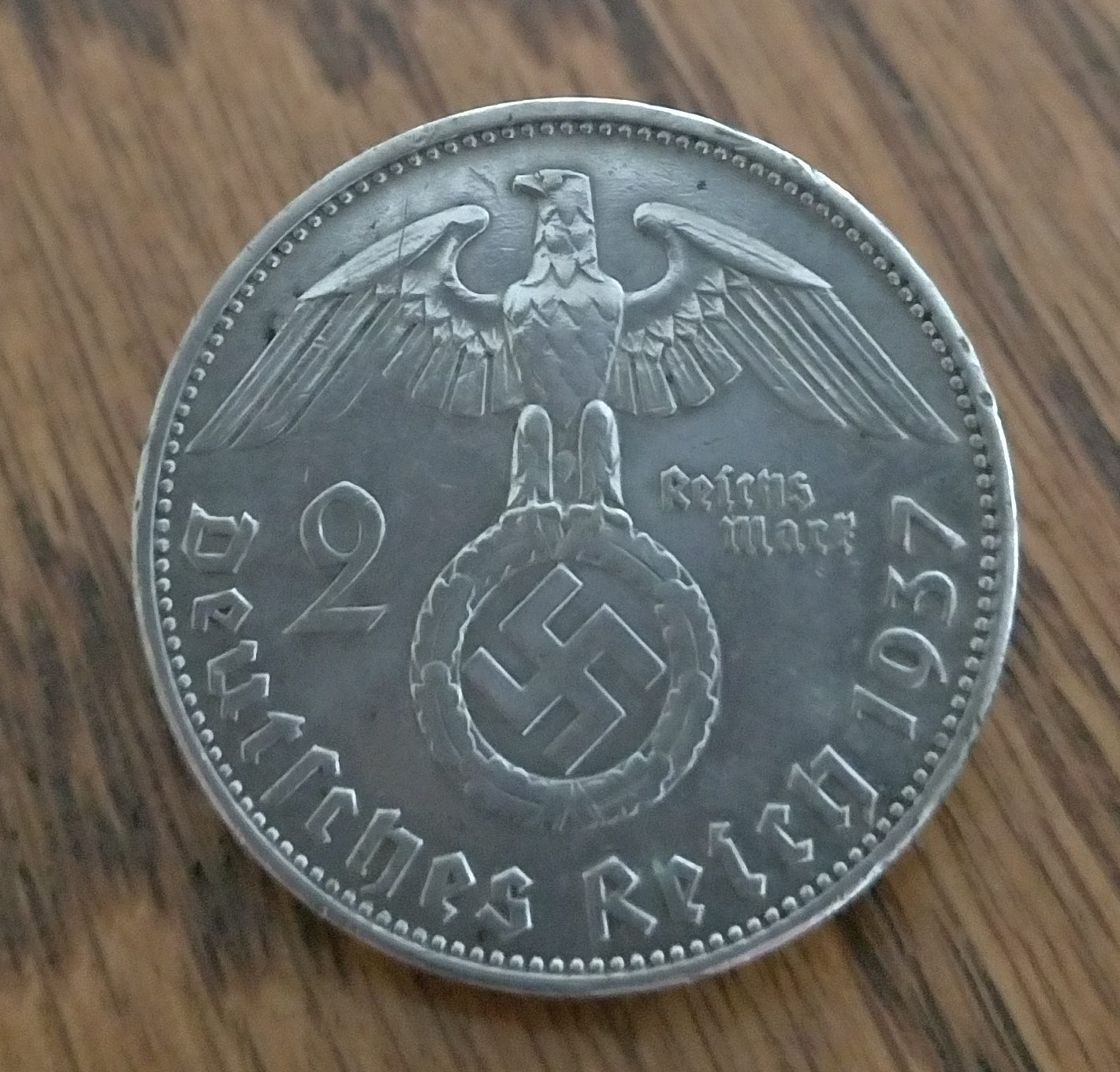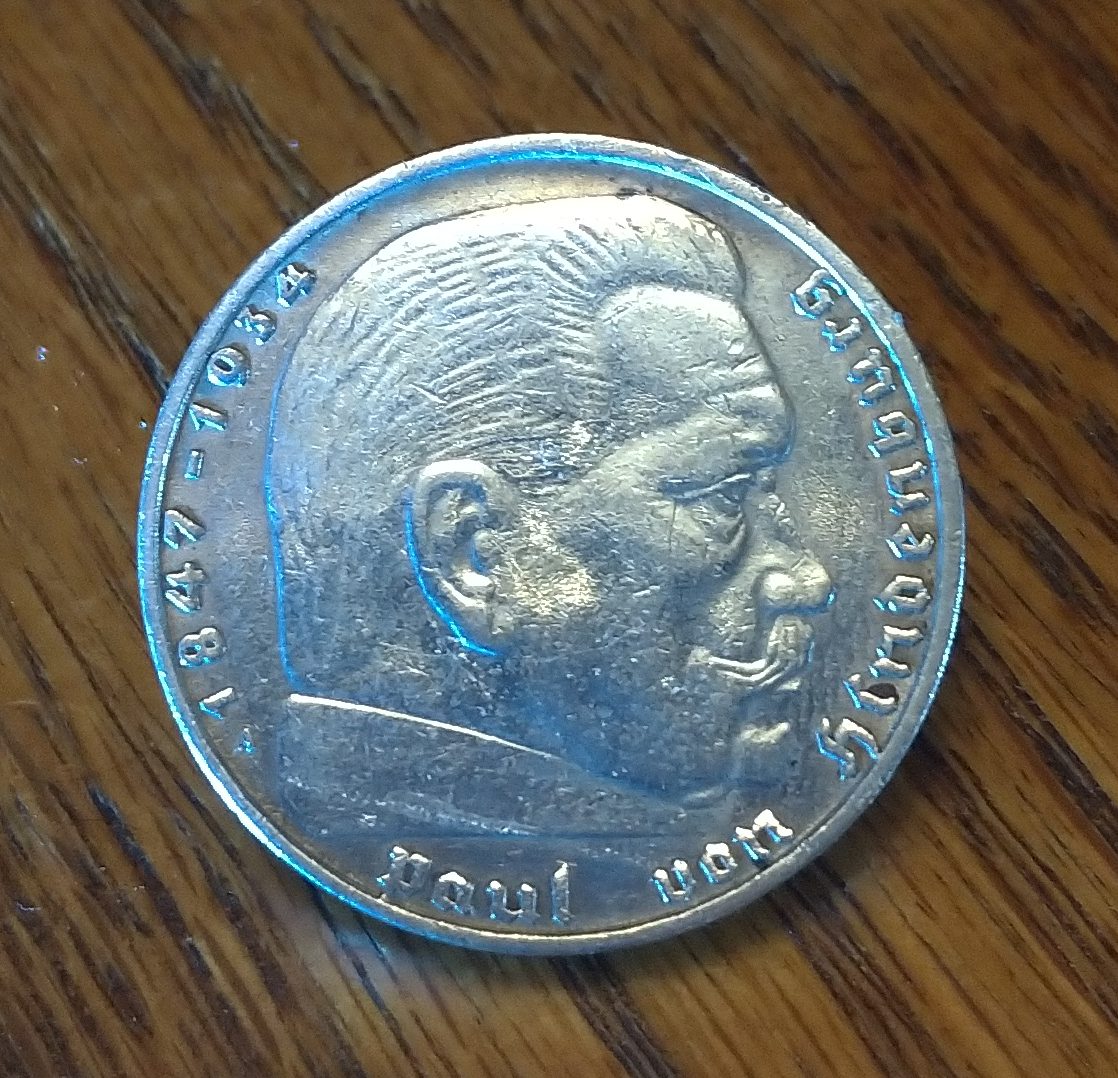Country or Region: Germany
Year: 1937
Created from: 1936-1939
Value: 2 Reichsmark
Weight: 8 g
Diameter: 25 mm
Composition: Silver (0.625)
Estimated Modern Value:

Obverse
2 Reichs
Mark
Deutsches Reich 1937

Reverse:
1847-1934 Paul von hindenburg
Edge Inscription:
Gemeinnutz geht vor Eigennutz
Translation:
Common good takes priority over self-interest
Paul von Hindenburg (1847-1934)
Son of a Prussian officer and a middle-class mother, Paul Ludwig Hans Anton von Beneckendorff und von Hindenburg was born in Posen, Prussia (now Poznań, Poland). His first military service began when he just only 11 years old as a cadet in the Austro-Prussian War of 1866. Although he retired as a general in 1911, he was promptly called back into service in 1914 to act as a nominal superior of a Major General by the name of Erich Ludendorff. Although it is reported that Ludendorff’s brilliance was responsible for the success of driving out a Russian invasion force from Prussian territory, Hindenburg received the Nation’s applause. As a result, Hindenburg’s reputation and name began to rival that of the Emperor of Germany, William II. After his promotion to field marshal, Hindenburg was given command of all German land forces by the Emperor with Ludendorff as a co-responsible chief aide.
As the First World War unfolded, Hindenburg and Ludendorff were unsuccessful in the war on land and resorted to unrestricted submarine warfare in order to starve Britain into surrendering. This decision led to the involvement of the United States of America joining in the war, which eventually led to Germany’s defeat in the war. After their failure, Ludendorff took the blame.
In 1918, William II was overthrown by a new republican government. Hindenburg collaborated briefly with this government before retiring a second time in 1919.
Several years later – in spite of his antirepublic views – in 1925 after the death of the first Weimar Republican President, Friedrich Elbert, Hindenburg was elected. Before long, however, he was under pressure from his personal confidants to implement a more authoritarian regime and create a more independant government from parliamentary (Reichstag) controls.
Although the government broke up again as the depression set in, Hindenburg managed to appoint a Cabinet resting on his confidence and authorized Chancellor Heinrich Brüning to dissolve the Reichstag if it did not cooperate. It was dissolved in 1930, and Chancellor Brüning was left to govern the country nearly exclusively by decree. However, since Hindenburg’s presidential signature was required on each decree, the president could veto any government decision.
With this power, Hindenburg began to spend enourmous amounts of money on army and navy, neglecting the other needs of German, like unemployment benefits. In the face of further economic problems for Germany, the Nazi party began to spur more unrest all over the country. After his presidential term ended in April, 1932, Hindenburg was relected. Hitler came close second in the election.
Although Hitler narrowly lost, mostly due to fear of the Nazi’s brutality and lawlessness, many of Hindenburg’s closest confidants believed the party to be useful – and reconcilable. He was eventually convinced to dismiss his chancellor – whom had contributed to his reelection.
For the Nazis to cooperate or participate in any government, Adolf Hitler insisted on becoming chancellor. However, Hindenburg did not trust Hitler and refused to appoint him as chancellor.
Two previous successive governments had failed to win over the Nazis. Franz von Papen, the head of one of those governments, assured Hindenburg that Hitler could be controlled. In November of 1932, Papen and Hitler agreed on a governement with Hitler as chancellor, Papen as vice chancellor, and other posts filled by non-Nazis. When Kurt von Schleicher, the opponent of Papen and Hitler’s joint governement, failed to obtain parliamentary support for his own government, Hindenburg asked for his resignation. A few months later, in January of 1933, Hindenburg appointed Hitler chancellor of a new Cabinet.
This new cabinet, with Hitler as chancellor, contained two other Nazi members: Wilhem Frick and Göring. It did not take much time for Hitler to obtain more power than Papen and Hindenburg intended through various means using terror, manipulation, and false promises. Hindenburg quickly adapted to the situation, warming up to Hitler considerably and becoming a supporter.
When he died the following year in 1934, he was a still a highly respected national figure of Germany.
Coin
When this coin was struck in 1937, Paul von Hindenburg (pictured) had already died. Adolf Hitler was already in power, having been appoint chancellor by Hindenburg in 1933 and declared himself Führer the following year in 1934.
By 1937, Anti-Semitism was already law and Anti-Semetic propaganda was increasing in intensity, with a travelling exhibition touring the country, casting Jews as the enemy, which nearly half a million people attended.
References
https://www.britannica.com/biography/Paul-von-Hindenburg
https://www.bbc.com/timelines/z86nfg8